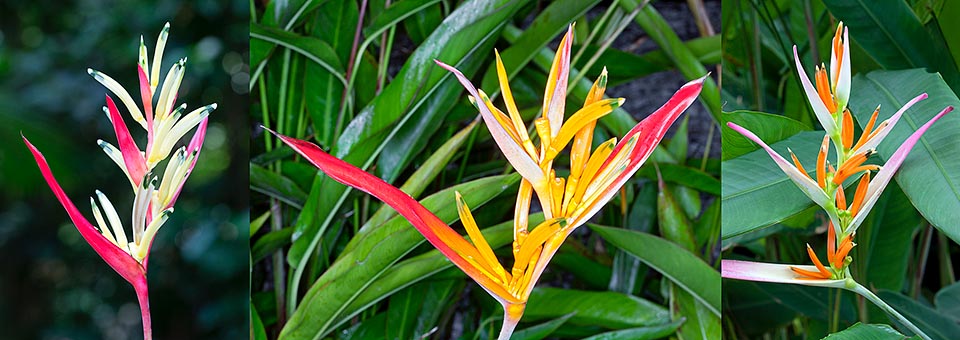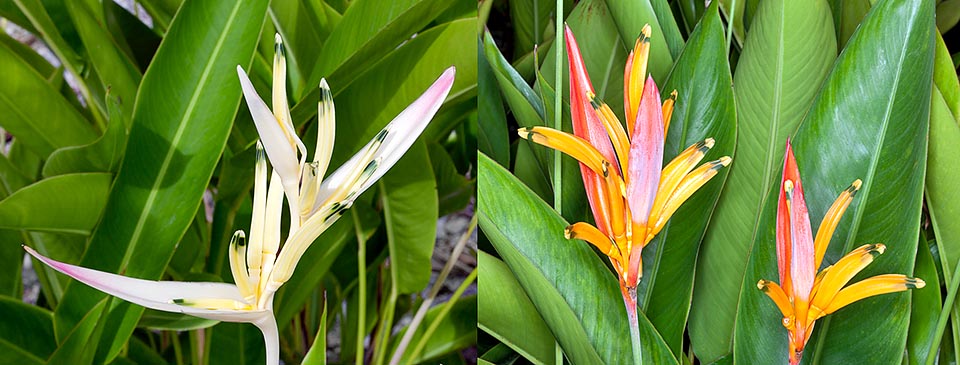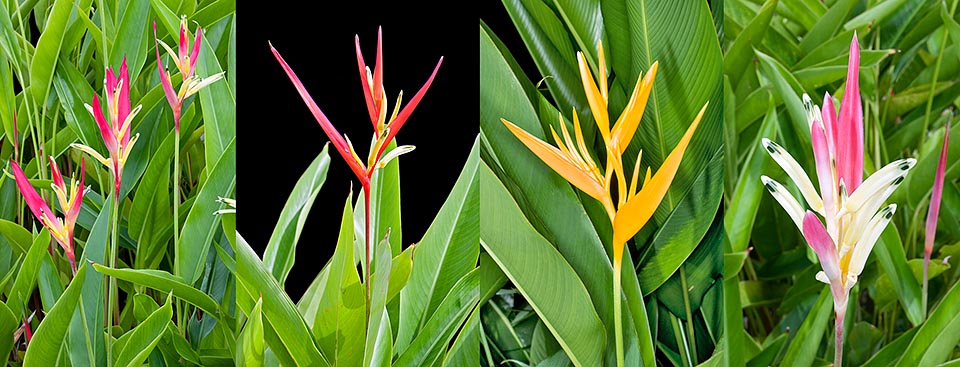Family : Heliconiaceae

Text © Pietro Puccio

English translation by Mario Beltramini
Heliconia psittacorum botanical form with the typical inflorescence © Giuseppe Mazza
The species is native to Bolivia, Brazil (Acre, Alagoas, Amapá, Amazonas, Bahia, Ceará, Espírito Santo, Federal District of Brasilia, Fernando de Noronha, Goiás, Maranhão, Mato Grosso, Mato Grosso do Sul, Minas Gerais, Pará, Paraíba, Pernambuco, Piauí, Rio de Janeiro, Rio Grande do Norte, Roraima, Rondônia, São Paulo, Sergipe, Tocantins and Trindade), Colombia, French Guyana, Guyana, Panama, Surinam, Trinidad and Tobago and Venezuela where it grows in the humid forests, mainly in open areas or on the banks of water streams, from the level of the sea up to about 1500 m of altitude.
The name of the genus comes from the Latin “Heliconius, a, um” = of the Helicon, mountain sacred to Apollo and to the Muses in the Greek mythology; the name of the species is the plural genitive of the Latin substantive “psittacus” = parrot, with reference, after some, to the shape of the flowers recalling the beak of the parrots.
Common names: false bird-of-paradise, golden torch, Japanese canna, parakeet heliconia, parrot’s beak, parrot’s flower, parrot plant (English); balisier bec de parroquet, héliconie des perroquets (French); helicônia-papagaio, caetê-tocha (Portuguese-Brazil); flor del papagayo, pico de loro (Spanish).
The Heliconia psittacorum L.f. (1782) is an evergreen, perennial rhizomatous erect herbaceous species quickly forming 0,8-1,5 m tall dense tufts. The leaves, on an about 25 cm long petiole, are basal, alternate, simple, entire, elliptic-lanceolate to oblong-lanceolate with pointed apex and prominent central nervation in the lower page, 35-55 cm long and 4-12 cm broad, of bright intense green colour above, paler below, and sheathing tubular foliar bases forming a pseudo-stem of about 2,5 cm of diameter.
The inflorescence, on a 15-55 cm long peduncle, is an erect 6-12 cm long terminal spike with slightly waved rachis, usually orange, and 3-7 alternate, lanceolate, concave, waxy, bracts, slightly spaced, red to bright orange red, at times pink or lilac, the basal one 8-15 cm long, the others progressively decreasing. The bracts subtend 3-9 flowers, on a 1,6-1,8 cm long pedicel, tubular, usually orange with dark green spot towards the apex, 3-5 cm long. The flowers, with bilateral symmetry, are hermaphroditic, with 3 sepals, two of which merged and one free, and three petals fused together, little spaced between them, 5 fertile stamina and one staminode opposite to the free sepal; the flowers are pollinated by the hummingbirds. The fruits are sub-globose drupes initially yellow to orange, then glossy dark blue when ripe, of about 0,8 cm of diameter, containing 1-3 seeds.
It reproduces by seed, kept in water for 3 days to soften the tegument, in organic loam with addition of siliceous sand or agri-perlite for a 30%, maintained humid at the temperature of 26-28 °C, with germination times varying from some weeks to some months and first flowering after 3-4 years, by micro-propagation, to obtain disease-free plants, but usually and easily by division of the rhizomes in spring, with each section provided with several vegetative buds. In many areas where it has been introduced, it has escaped the cultivation naturalizing, becoming, in some instances, infesting.

Already variable in nature species, pollinated by hummingbirds, has originated countless colourful cultivars blooming almost continuously © Giuseppe Mazza
One of the smallest and more diffused Heliconia with almost continuous flowering all around the year, of which have been selected numerous varieties with different colours and which has originated some hybrids, utilizable in parks and gardens as isolated group, in mass as soil cover, or for edges exclusively in the humid tropical and subtropical climate zones, in full sun or slight shade. Vigorous species adapting quite easily to different cultivation conditions, but growing best on soils rich of organic substance, acidic or neutral, draining, maintained almost constantly humid, but without stagnations and in position sheltered from the winds which would cause damage to the leaves. In zones having prolonged dry periods, it must be frequently and abundantly watered, especially in the warmest months. In poor or alkaline soils, it may be subject to chlorosis to be treated with the application of fertilizers with microelements, in particular iron, under form of chelates.

The tubular flowers of this perennial rhizomatous herbaceous, forming 80-150 cm tall dense tufts, show almost always an apical dark green spot © Giuseppe Mazza
Once the flowering completed, it is good to cut at the base the pseudo-stem to stimulate the growth of new vegetations and the production of other floral stems. It is successfully cultivated also in pot, where it easily blooms, utilizing an organic substratum particularly draining and aerated, for the decoration of patios and terraces or to be sheltered in greenhouses, verandas and winter gardens particularly luminous, where the climate does not allow the permanence in open air during the winter months, with high values of ambient humidity, 70-80% or more, and of day temperatures, ideal 24-26 °C, with lowest night values not under the 15 °C. The watering must be regular and abundant in summer, letting the substratum to partially dry up before watering again, avoiding stagnations, cause of easy rottenness, more spaced in winter, but without ever allowing the substratum to dry up completely, with fertilizations, in spring-summer, done preferably with slow-release balanced products with addition of microelements.

The 6-12 cm spike inflorescences, carried by a 15-55 cm peduncle, are protected by showy, even 15 cm long bracts © Giuseppe Mazza
It is easily subject to mites and mealy bugs attacks, to be treated in case of serious infestation with specific products. The cut inflorescences, long lasting, 2-3 weeks, are particularly appreciated in the floral compositions and their market is in continuous expansion.
Synonyms: Musa humilis Aubl. (1775); Heliconia ballia Rich. (1792); Heliconia marantifolia G.Shaw (1796); Heliconia humilis (Aubl.) Jacq. (1797); Heliconia swartziana Roem. & Schult. (1819); Musa humilis Perrault (1825); Heliconia cannoidea A.Rich. (1831); Heliconia andrewsii Klotzsch (1847); Heliconia schomburgkiana Klotzsch (1847); Heliconia aurea Linden ex Lem. (1862); Bihai cannoidea (A.Rich.) Kuntze (1891); Bihai psittacorum (L.f.) Kuntze (1891); Bihai humilis (Aubl.) Griggs (1904); Bihai sylvestris Gleason (1925); Heliconia sylvestris (Gleason) L.B.Sm. (1939); Heliconia goiasensis Barreiros (1976); Heliconia bahiensis Barreiros (1978).
